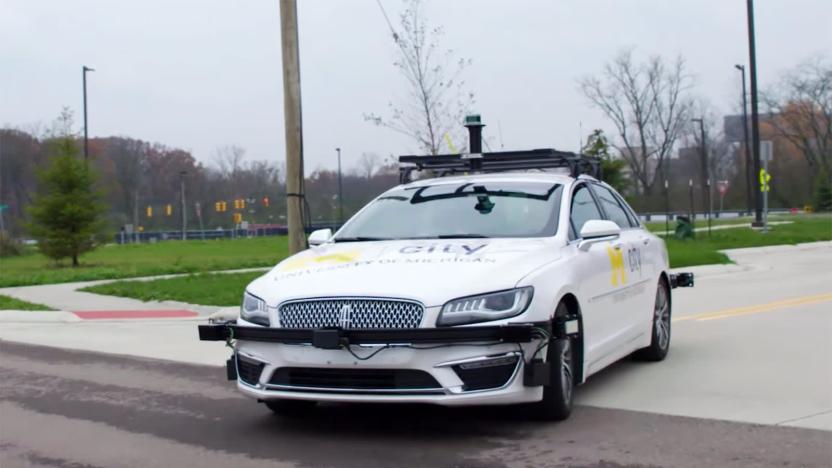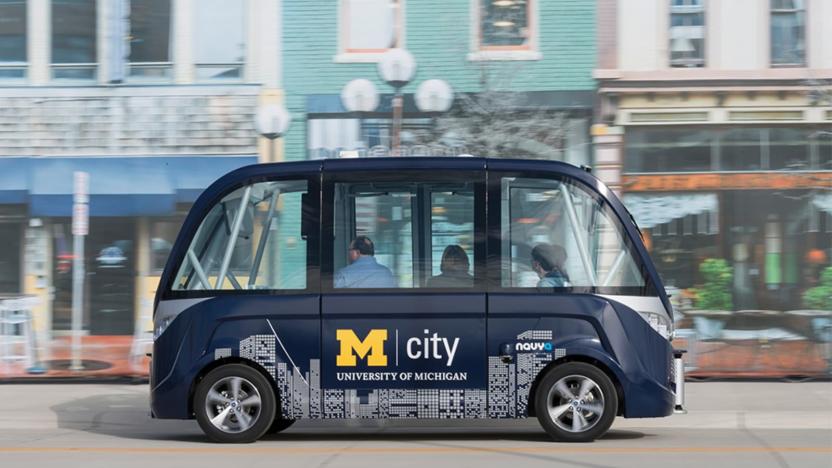mcity
Latest

University of Michigan's self-driving car lab now runs on Verizon 5G
Verizon (Engadget's parent company) is continuing its very gradual 5G rollout, but this time it's more about the future of transportation than the phone in your hands. The carrier's 5G network is now live at the University of Michigan's Mcity test facility to provide a boost to connected self-driving cars. In theory, the combination of abundant bandwidth with low lag will help autonomous vehicles share crucial data with each other, city cameras and traffic lights to make more informed decisions. A car could receive word of a crash ahead in time to maneuver out of harm's way, or use traffic lights to warn pedestrians before they cross the street.

Self-driving cars are safer when they talk to each other
Most current self-driving technology relies on cameras, radar and lidar. These sensory devices serve as eyes for the car, mimicking what a human driver can see. But a University of Michigan public-private partnership called Mcity is testing V2V, or vehicle to vehicle communication, and has found that it makes their autonomous prototypes even safer.

Self-driving shuttles are coming to the University of Michigan
The University of Michigan is a hotbed for self-driving car research, so it stands to reason that students and faculty should use self-driving vehicles to get around, right? The university clearly thinks so. Mcity (the university's public-private partnership) is launching a free driverless shuttle service that will see two 15-passenger Navya Arma vehicles transport people between the university's North Campus Research Complex and the Lurie Engineering Center. This will make the 2-mile trip easier for travelers tired of taking campus buses, as you might guess, but it'll also serve as an experiment in its own right.

Researchers find a more effective way to test self-driving cars
It's tricky to test self-driving cars. Even if you have hundreds of thousands of miles under your belt, it's still difficult to account for every possible real-world peril. Researchers think they can fast-track that experience, however. They've developed a sped-up testing process that should accomplish a lot in just a small amount of time. Instead of a holistic approach that gauges everything at once (and often goes for miles without a meaningful event), the new method breaks things down into individual components you can test frequently and repeatedly in simulations. If you want to gauge the car's reaction to someone cutting you off, for instance, you just focus on that -- you use stat analysis to determine how the car would behave in "boring" moments.

Ford is testing autonomous cars in the snow
If you've ever driven in the snow you know how difficult and dangerous it can be. Which makes Ford's announcement that it's testing fully autonomous cars in this less-than-optimal environment better suited for skiing pretty exciting. The test vehicles use LiDAR and high-resolution 3D mapping to keep to stay on the road when the cameras and other sensors are made useless by the reduced visibility of snow flurries.

Ford first to test self-driving cars in Michigan's fake city
The University of Michigan recently built the 32-acre "Mcity" proving ground so that automakers could test autonomous vehicles with zero risk to the public. Since the faux city is in US car country (and far from Silicon Valley rivals like Google), it's only fitting that it was broken in by a small Dearborn outfit: Ford. The automaker tackled Mcity in its latest Fusion Hybrid self-driving car, freshly equipped with four LiDAR sensors for real-time 3D mapping. While Ford has tested its vehicles extensively on public roads, "every mile driven [at Mcity] represents 10, 100 or 1,000 miles of on-road driving in terms of our ability to pack in the occurrences of difficult events," said U of M professor Ryan Eustice.



